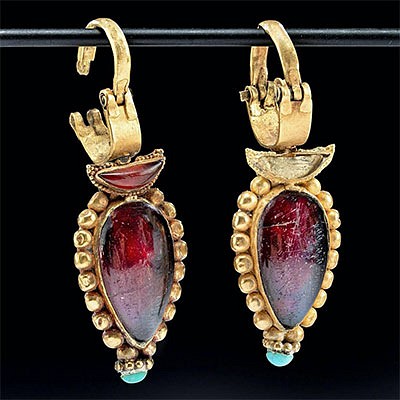3 Fine Jamacoaque Pottery Animals - Jaguars & Monkey
Lot 54
About Seller
Artemis Gallery
686 S Taylor Ave, Ste 106
Louisville, CO 80027
United States
Selling antiquities, ancient and ethnographic art online since 1993, Artemis Gallery specializes in Classical Antiquities (Egyptian, Greek, Roman, Near Eastern), Asian, Pre-Columbian, African / Tribal / Oceanographic art. Our extensive inventory includes pottery, stone, metal, wood, glass and textil...Read more
Categories
Estimate:
$500 - $750
Absentee vs Live bid
Two ways to bid:
- Leave a max absentee bid and the platform will bid on your behalf up to your maximum bid during the live auction.
- Bid live during the auction and your bids will be submitted real-time to the auctioneer.
Bid Increments
| Price | Bid Increment |
|---|---|
| $0 | $25 |
| $300 | $50 |
| $1,000 | $100 |
| $2,000 | $250 |
| $5,000 | $500 |
| $10,000 | $1,000 |
| $20,000 | $2,500 |
| $50,000 | $5,000 |
| $100,000 | $10,000 |
| $200,000 | $20,000 |
About Auction
By Artemis Gallery
Nov 11, 2021
Set Reminder
2021-11-11 12:00:00
2021-11-11 12:00:00
America/New_York
Bidsquare
Bidsquare : It's a Small World | Diminutive Artifacts
https://www.bidsquare.com/auctions/artemis-gallery/its-a-small-world-diminutive-artifacts-7836
Join us for a very special auction featuring art & artifacts from East to West, North to South, and everywhere in between - with one small thing in common - size! Everything in this auction is approximately 6 inches or less - perfect for that last bit of shelf space in your curio cabinet! Artemis Gallery info@artemisgallery.com
Join us for a very special auction featuring art & artifacts from East to West, North to South, and everywhere in between - with one small thing in common - size! Everything in this auction is approximately 6 inches or less - perfect for that last bit of shelf space in your curio cabinet! Artemis Gallery info@artemisgallery.com
- Lot Description
Pre-Columbian, Ecuador, Jamacoaque (Jama Coaque) culture, ca. 500 CE. A trio of mold-formed pottery effigy creatures! The slightly squat and rounded animal is a monkey, sitting with his head bearing a snarling expression, and faint blue-green pigment highlights his face. The head features a pair of circular, bulging eyes set behind a protruding snout with teeth bared. A slinky tail curls up his back, and bracelets adorn his front paws. The other two animals perhaps represent jaguars that sit similarly, crouching with their four feet tucked in front. Their faces are also furrowed into expressions of ferocity; their tongues protrude from between their large fangs. All 3 are hollow with one or two vent holes for firing and contain esoteric elements perhaps to symbolize shamans transitioning into animal forms. Size of monkey: 3" L x 3" W x 3.5" H (7.6 cm x 7.6 cm x 8.9 cm); larger jaguar: 2.25" L x 2" W x 4" H (5.7 cm x 5.1 cm x 10.2 cm)
Provenance: private Fort Lauderdale, Florida, USA collection; ex-Minerva Gallery; ex-Benjamin Vega, California, USA, acquired in 2006 to 2007; ex-Gene and Virginia George, brought to the USA from 1961 to 1966
All items legal to buy/sell under U.S. Statute covering cultural patrimony Code 2600, CHAPTER 14, and are guaranteed to be as described or your money back.
A Certificate of Authenticity will accompany all winning bids.
PLEASE NOTE: Due to recent increases of shipments being seized by Australian & German customs (even for items with pre-UNESCO provenance), we will no longer ship most antiquities and ancient Chinese art to Australia & Germany. For categories of items that are acceptable to ship to Australia or Germany, please contact us directly or work with your local customs brokerage firm.
Display stands not described as included/custom in the item description are for photography purposes only and will not be included with the item upon shipping.
#167904Small jaguar is intact with faint remains of red pigments. Monkey tail is repaired and reattached to body, with faint adhesive visible, though rest of body is intact with remains of blue pigments on face. Largest jaguar on stand is intact with earthen and mineral deposits scattered on surface.Condition
- Shipping Info
-
All shipping is handled in-house for your convenience. Your invoice from Artemis Gallery will include shipping calculation instructions. If in doubt, please inquire BEFORE bidding for estimated shipping costs for individual items.
-
- Buyer's Premium



 EUR
EUR CAD
CAD AUD
AUD GBP
GBP MXN
MXN HKD
HKD CNY
CNY MYR
MYR SEK
SEK SGD
SGD CHF
CHF THB
THB













